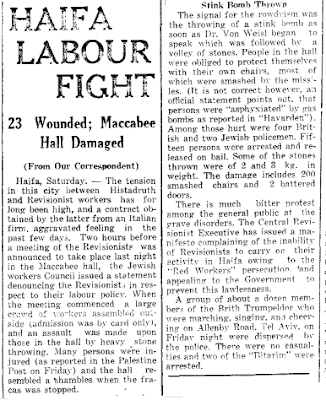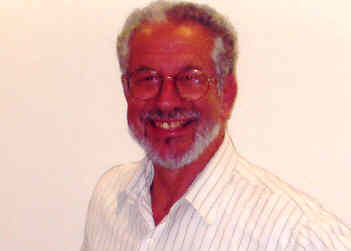The storming of Haifa’s Maccabi
Hall, 1934
By Yisrael Medad
Published in the Jerusalem Post Weekend Magazine, November 17, 2023
On Thursday evening, October 18,
1934, at 9:15 PM, Dr. Wolfgang-Ze'ev von Weisel ascended the platform of the Maccabi
Hall in Haifa located where Herzl and Balfour Streets join, near the old Reali
High School site. He was facing less than 100 listeners
who had purchased tickets to hear him speak on the topic "The status of
the Jews in Europe and the Question of the Saar Region and the National
Petition". He never finished his presentation. In fact, he barely got a
word out.
Viennese-born, as his father, who was an officer of the
Austro-Hungarian Army, von Weisel also served and was wounded in World War I.
He came to Mandate Palestine in 1922 and was an instructor in the early Hagana
officers’ training school in 1924. He became an early disciple of Ze'ev Jabotinsky and a leader in
the Revisionist Party. He was a renowned syndicated journalist and, covering
the outbreak of the 1929 riots in Jerusalem, he was stabbed and seriously
injured.
The anti-Revisionist atmosphere in
Haifa at that time was especially vitriolic especially following the murder of
Haim Arlosoroff in June 1933 with the suspicion of guilt falling on the
Revisionists. Mapia's Haifa branch decided that Revisionists must be
"dismissed from work and deprived of their livelihoods; we must create an
atmosphere of moral contempt and personal boycott, on the streets, at work, and
wherever we can exert influence." This resulted at the end of July 1933 in
the dismissal of Revisionists and Betarim from jobs in Histadrut enterprises.
A new labor clash, this one in Haifa at a
construction site, began to develop in January 1934. Contractor David Shmuel-David
was engaged in constructing an apartment building in the Herzliya neighborhood
just west of Hadar Hacarmel. He employed not only Histadrut-affiliated workers
but didn’t see any problem with Betarim even though, technically, they were
unorganized.
On one occasion, when, short of laborers, he
asked of the Haifa Labor Council to employ Betarim in addition to Italians and
Arabs. That body insisted that he employ only organized labor and to exclude the
Betar members. When he refused and hired them anyway, the Labor Council called
a strike. Abba Hushi, head of the Haifa Labor
Council, spoke in the name of 6000 workers and felt he could bully anyone who
opposed his vision of "Labor Palestine".
The Betar
members who had been called in, were declared strikebreakers. Other buildings
in Haifa belonging to the contractor, as well as those of a Weinstein, were
demolished. The few Betarim who did get though and worked were repeatedly
attacked by mobs of party activists and the police had to intervene.
Previously, Mapai had sanctioned a muscle group set up by Yitzhak Ben-Aharon
called Hever Hape'ilim ("The Activists"), the practical organization of
which was in the hands of Ben-Aharon, Yosef Almogi of Haifa's Labor Council and
Yosef Avidar of the Tel Aviv Labor Council and also a member of the Hagana
command.
The rank and file were organized into
"Hapoel Squads," within the framework of the Hapoel Sports
Organization. They were controlled by the labor councils in the cities,
especially Tel Aviv and Haifa, which provided funds. Yet, by the Histadrut denying Betarim the right to
work because they were unorganized, and denying them the right to organize
themselves within their own labor exchange, the local labor councils left the
Betarim few alternatives other than breaking strikes so that they could earn
money for their physical existence. Clashes were inevitable.
Two additional occurrences fed into the
events of October 18. In July, Avraham Stavsky was found not guilty of
Arlosoroff's murder after a three-month long trial that filled the newspapers
almost daily. Moreover, in late August that year, the Revisionist movement
appealed to Mapai to reach understandings so as to remove from inter-party
activities any violence as well as to achieve a modus vivendi for resolving
labor disputes which had plagued the Yishuv ever since February 1928 and, in
greater intensity, since October 1932 when, at the Froumine Biscuit factory in
Givat Shaul in Jerusalem, Betarim were beaten up for strikebreaking.
During an earlier discussion at a Mapai
Central Committee session in June 1934, Moshe Beilinson, member of the
Histadrut's Executive Committee, decried the fact that "Our movement's
image is becoming more and more distorted. For the past two years, the use of
physical force has become our answer to everything…We, for our part, have only
one response: force! Strikebreakers, unorganized labor, employment of Arabs,
children in uniforms we don't like, calling Stavsky to the Torah. Everything is
an abomination and our reaction is always the same: Let them have it!" His
criticism fell on deaf ears in Haifa.
In Haifa, it was Labor Zionist policy that
no Revisionist meeting could take place even in a closed hall and by
invitation. And so, outside the Maccabi Hall that Thursday evening were about
1500 protestors recruited from Hapoel squads, kibbutzim and socialist youth
movements. As soon as the meeting began, there were disturbances from several
socialists who had purchased tickets to be on the inside. The doors were broken
down and the mob began to stone those inside.
A stink bomb was thrown which caused
vomiting and dizziness in the enclosed space. Windows were smashed. Furniture
was overturned. Over twenty people (40 according to Haaretz, among them 7 police
personnel) were injured, among them,
Von-Weisel himself whose head was cut. Four, including two children,
passers-by, required hospital treatment and one, 15-year old A, Rundstein, had
his head operated on. Police officer Blumstein needed medical attention, too.
Fifteen were arrested but released on bond. When
the contretemps ended, hundreds of labor youth movement members marched in
formation through the streets of downtown Haifa singing a workers' march, “Kadima
HaPoel”.
The immediate result was that the Betarim and
Revisionists gained much sympathy within the parties and non-socialist parties.
The Vaad Haleumi established an inquiry commission. At the Mapai Central
Committee convened on October 21, 1934, Golda Meyerson (later Meir) declared:
"How could our people sing that night in Haifa?! The youngsters who
participated in the action should at least have been ashamed and not flaunted
their 'victory'…to organize 1500 people in order to throw eighty Revisionists
out of a closed meeting, that's not brave."
Many more Mapai leaders recalled the view of Berl
Katznelson who earlier had identified Mapai’s problem of Mapai as the looming "fascisization
of the labor movement".
Despite the gain, the Revisionists and the Betar
members lost a larger battle. Ben-Gurion's talks with and tentative agreements
with Jabotinsky in London mediated by Pinhas Rutenberg during 16 meetings that
were held over a period of a month in 1934, first broached in mid-August, were
put to the test in a vote of authorization by the members of a special
Histadrut convention on March 24, 1935. Those who opposed inner
Zionist peace numbered 11,522 and those who sought to continue the exclusionary
and discriminatory policies garnered
16,474 votes.
The socialist camp’s willingness to justify
violence against its ideological rivals stemmed from the European tradition of
the working-class who believed employing force to ensure the right to work, on
the one hand, and, on the other, identifying Revisionism with fascism on the background
of events in Berlin, Rome and more recently, Vienna.
When that formula took hold, the next logical
step was to assume it was quite legitimate for workers to attack them even as
they were of the same economic class. In later years, the Yishuv would witness
the Saison campaign to hunt down members of the dissident undergrounds and the
Altalena Affair. The poison that temporarily reached a crescendo in Haifa has
seemingly continued its nefarious influence as we witnessed the crashing of a Likud assembly in
Raanana on September 4 and the daubing of the Bet
Jabotinsky in red this past weekend in Tel Aviv.
Among other sources, including the
press at the time, I note Anita Shapira's article, "The debate in Mapai on the use of violence, 1932–1935", in Studies in Zionism, 1981.
Some newspaper articles and a photograph of Wolfgang-Ze'ev von Weisel
"The Red Pogrom in Haifa"







































